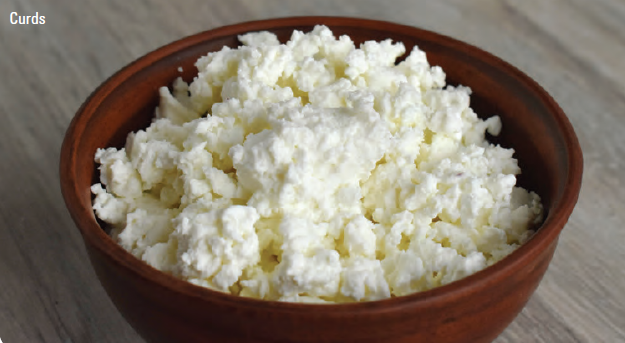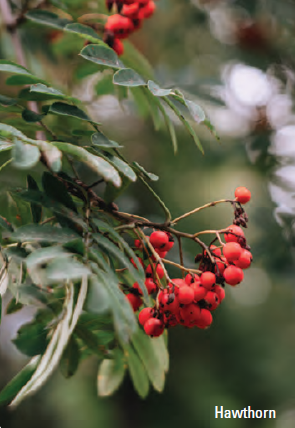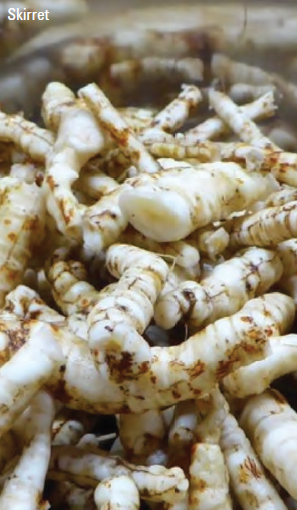Ancient Irish Cuisine: Irish cuisine in its original, ancient form was fascinating to foreign visitors over the centuries. Let’s revive it!
We have let a lot of unique, healthy, and interesting food fall by the wayside. Here are some traditional Irish foods that need some reviving!
Modern Irish cuisine is famous all over the world – potatoes, potatoes, and more potatoes. But as we all know, this is a very modern addition to our diet. What about the stuff that we ate before potatoes became our soul food?
We know what our far ancestors ate because it has been documented in Irish mythology and early Irish literature. We also know what early Irish people ate by examining what was inside the stomachs of various bodies of poor souls that died and their bodies were mummified in one way or another.
Here are some foods from early Ireland that are definitely worth reviving.
Ancient Irish Cuisine: Milky Stuff
Irish grass is the best in the world. Our cows produce epic dairy. Over the centuries, pretty much, the main thing that kept us alive was milk and milk products. But. This isn’t the stuff we know of today, it was way more weird and cool.
Even in ancient times, our food revolved around banbidh, or “white foods.” This dairy extravaganza included drinking milk, buttermilk, fresh curds, and old curds. Yes, old curds!
Curds are a by-product of coagulating milk. This happens when an acid, like lemon juice or vinegar, is added to dairy. Milk proteins clump together, and it also happens naturally if milk is left to sour. It’s the first step of cheese production. Its nearest modern equivalent is cottage cheese, although curds are a rougher, less processed version.
The takeaway here is that curds were a big deal to the early Irish. And let’s not forget about whey – the liquid that is leftover after the curds are drained. Whey was mixed with water, and it was branded as a sour drink that was refreshing and filling.
Brits and Milk
In the year 1690, a visiting Brit reported that the Irish consumed milk “above twenty several sorts of ways and what is strangest for the most part love it best when sourest.”
The Brit was talking about bainne clabair – thick milk. The Irish loved it and drank it enthusiastically. In fact, the Brits in charge of quelling Irish rebellions even suggested that the best way to starve out the Irish was to just kill all the cows.
King among all dairy products, however, was butter. But it wasn’t butter as we know it today, there were flavoured butters of every variety! Onion and garlic were staples for favouring butter, but there were other varieties as well, depending on local tastes. And of course, there was bog butter.
Butter was stored in bogs for longevity purposes initially and left to ferment. But soon the butter started to take on the flavour of the bogs. In time, butter was valued for its bogginess!

Ancient Irish Cuisine: Oats
The oat has been around in Irish diets for a long, long time. Oats were easier to grow in colder climates than wheat. Oats were seen as poverty food, for the peasants, and wheat was a treat. In fact, an Irish saint called Molua had the power to make any crop he planted turn into wheat. This was concluded to be a confirmation of how holy he was. Which is nice work if you can get it.
There were a few different ways the Irish negotiated the oat. One was as a porridge, which we still have today. But the other was the oat cake. These were cooked on a griddle or on a bake stone (ovens hadn’t quite caught on at this stage).
Like with milk, the Irish made a wild variety of food from one ingredient. As for oats, one of the more interesting dishes was a food called sowans or sowens. This was a type of fermented oat milk made using the starch on the inner husks of oats after milling.
Husks
The husks are soaked in water for a few weeks, along with the oatmeal, and left to ferment. After this, the liquid part, called swats, is poured out and is a separate drink in its own right. The water in which the oaten meal is steeped is known as a “bull milk,” and during lent of olden times it was drunk instead of milk.
When milk was scarce, people used bull milk with porridge as a substitute. The remaining sowans were boiled with water and salt until thickened. It was then eaten with butter or dipped into milk. Sadly, the art of making sowans now is almost lost.
Oats were also made into a jelly called flummery. The starchy set-jelly dessert was also made by soaking oatmeal overnight in water. The liquid from this was boiled with sugar and flavourings such as rosewater. Then it was put into a mould and left to set. It was served with cream or honey.
The word ‘flummery’ means ‘empty nonsense.’ This follows the tradition of naming desserts (or sweetmeats, as they were called) silly names to show they are unimportant. Flummery is up there with ‘flan’, ‘trifle’ and ‘fool’.
Ancient Irish Cuisine: Sloke
Sloke is any edible marine algae (such as sea lettuce, red laver, and Irish moss). Although, it can also be that slimy seaweed as well. Yikes.
Sloke comes from the Irish word sleabhac, and if you lived near the coast, this is what you ate. Edible seaweed like dulse was put into salads and was made into side dishes. But we should be eating this now in 2022. They are packed with nutrients, they are organic and if you collect it yourself, it is everyone’s favourite price – free.
Sloke grows on rocks in the tidal zone in winter. It is at its tastiest after a frost. During the famine, along with dulse, carrageenan and crannac, it kept many people from starving to death.

RECIPE
Method: Wash to remove sand. Squeeze. Put enough water in a pot to cover the bottom and boil. Add the sloke and stir until it is boiling.
Cook for 3 to 4 hours, and stir every now and again.
Add pepper and salt to taste.
To Dress: Stir in butter and cream. Eat on oatcakes, or with meat and potatoes.
Ancient Irish Cuisine: Crubeens
We eat a very sanitised version of meat these days compared to our ancestors. But we are missing out on some good nutrients and just plain variety if we just stick to muscle meat. So let’s bring back food like crubeens – boiled pig feet. The word comes from Irish crúibín, meaning “pig trotter.”
Celebrity chef Marco Pierre White once served trotters at his restaurant, and they have stayed on the menu ever since. After the Global Financial Crisis, there was a boom in the popularity of pigs’ trotters as cheap meat recipes became all the rage.
This delicacy is prepared by cleaning the feet and having the hairs pulled out. In Ireland, crubeens are boiled, then battered and fried. They are traditionally eaten like corn on the cob, using your hands.
As for meat though, the Irish never had a diet heavy in meat. This was helped along by the fact that eating meat was forbidden twice a week and during lent if you were a church-going human. Céadaoin, the name for Wednesday in Irish, means first fast. The name for Friday, Aoine means fast. So slow down on the pig’s feet, this is a special treat!

Crowberries
The humble crowberry has been forgotten and sent to the depths of history. But this is madness, as these hardy little berries can be tasty and useful. They look like a small blueberry and grow throughout heather on the mountains in Ireland.
The fruit is usually picked in Autumn, but if nobody finds the bush to take the fruit, the little purple guys cling on and can be picked in Spring – they will still be hanging there! This berry is a little bitter, so it is cooked rather than eaten raw. Cooking enhances the flavour, so pies are excellent when they have some crowberry content. Crowberries also make a delicious jam.
The berries keep well and have a high anthocyanin pigment content. They have been used in the past as a food dye. Across the regions where they grow, the stems from the bush are used to smoke fish like trout and salmon. In Scandinavia, the berries are treasured for making wine, juices or jelly. This fruit grows easily and can also be picked easily, so it is due a revival.
Hawthorn
The fruit of the hawthorn tree are called “haws.” Botanically, they are pommes. But, they look like berries. This little fruit have kept the Irish alive through hard times. A common expression in old Ireland was, “When all fruit fails, welcome haws.”
In fact, it’s not only the Irish that have survived because of haws. In Canada, during the early days of settlement, pioneers ate haws during the winter. They had no choice, it was the only food available. People from hawthorn areas are now called “haweaters.”
Traditionally, the haws are made into jelly or wine, and in fact, the leaves, if picked early, are also edible, and can be added to salads. In China, they make haws into snacks on sticks which are covered in sugar, plus the haws are made into liquor.

The best haw recipe is the one for haw ketchup.
1350g haws
350g. sugar
1.5 pints of wine vinegar
1 teaspoon salt
Cayenne pepper
Cook haws with the vinegar, simmering for about half an hour. Blend, then sieve to remove pips. Return the mixture to the pan with the sugar, salt and pepper, and boil for 15 mins, while stirring. The mixture will thicken slightly. Remove from heat and put it in a bottle and seal. Yum!
Fat hen
Fat hen goes by a lot of names, including lamb’s quarters, melde, goosefoot, or wild spinach. The leaves and young shoots can be eaten raw or cooked as a leaf vegetable. The flowers and the buds can also be eaten.
Fat hen has been around for as long as man has. Archaeologists have found it in storage pits and in ovens from the Iron Age and the Viking Age. There are seeds even inside the stomachs of Danish bog bodies. Fat hen was a staple before spinach came along and replaced it as the green of choice. But during the famine, people relied on fat hen to keep them alive.
It seems crazy that this little plant has fallen by the wayside as a food. Fat hen grows easily everywhere, and it is so good for us. It has more iron and protein than cabbage or spinach. Careful with the oxalates though!
The young shoots (less than 20 cm) and unopened flower spikes can be eaten like asparagus shoots. Just simmer them until tender (up to 10 minutes), drain and serve with butter.
Skirret
This is actually a fascinating plant that has completely fallen out of use as a food. In Irish, it was known as cearrachán, and was used as a root vegetable. It has a cluster of sweet, bright white roots. The taste and texture is reminiscent of sweet potatoes. Skirrets can be boiled, stewed, or roasted.
The woody core is inedible, so remove it before cooking! During medieval times, aristocrats mostly stuffed themselves with meat and wine. But one of the vegetables that slipped through the gluttony net was the skerrit. It was the preferred root vegetable, and was also known as crummock.
In Systema Horticulurae, or The Art of Gardening, written in 1677, gardener John Worlidge referred to skirret as “the sweetest, whitest, and most pleasant of roots.”
Once the roots have been pulled up, skirret can be eaten raw like a carrot, or cooked. The vegetable gets sweeter when oven-roasted. Yum!

The plant is a very low-yield crop, which is probably why it fell out of use. However, we really need to pull this one back from the brink and grow it ourselves. Imagine losing this little guy to history? There are many foods that were uniquely Irish that have almost been lost to history… what should you be growing in your garden to help keep Irish food history alive?
First published on www.oldmooresalmanac.com

